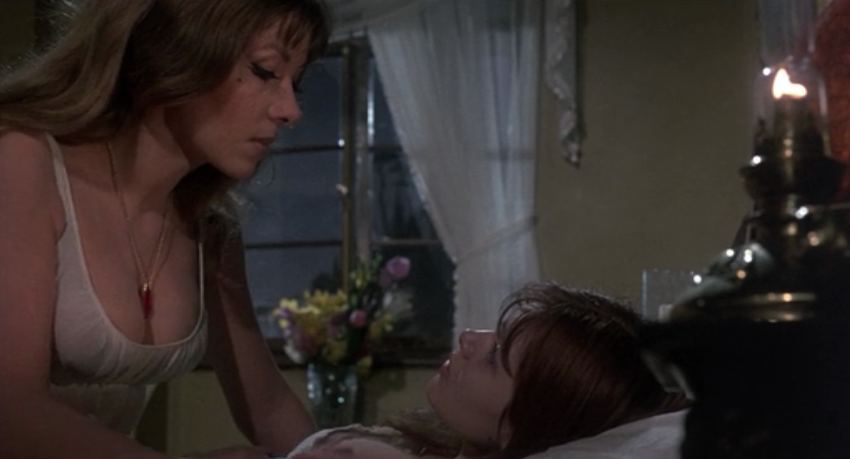This past week included the celebration of Dracula Day, a day dedicated to the King of Vampires and his many permutations. But we often forget about the other vampires, the vampires that were on the scene before old Drac arrived to twirl his mustache, seduce young ladies, and establish his kingdom of the undead. Vampires are often representative of transgressive sexuality, preying upon the unspoken desires and fears of their culture. So it’s no surprise that the Victorians especially obliquely associated vampirism with a fluid sexuality. One of the first lesbian vampire stories was the novella Carmilla by sensational novelist and all-around Gothic dude Sheridan Le Fanu.

Carmilla was published in 1872, more than twenty-five years before Bram Stoker’s Dracula, and stands with Polidori’s The Vampyre as one of the major works of vampire fiction. While Carmilla tends to get second billing to Dracula, it’s a remarkably influential novel, exploring the vampire tropes interaction with homoeroticism and the Victorian waif. It’s the basis of The Vampire Lovers, a Hammer horror film from 1970 that uses Carmilla to portray, perhaps for the first time in the Hammer horror canon, a lesbian vampire.
The Vampire Lovers tells the story of Carmilla (also known as Marcilla and Mircalla) (Ingrid Pitt), a buxom young lady vampire who cuts a swath through the Victorian waifs of the village. First she goes after Laura (Pippa Steel), the niece of General Spielsdorf (Peter Cushing), whom she seduces and kills. Then Carmilla goes on to form friendship with Emma Morton (Madeline Smith), with whom she stays while her aunt (or is it her mother?) visits a family member. The pattern with Laura is repeated, as Carmilla and Emma establish a “passionate friendship” and eventually become lovers, supplemented by Carmilla’s seduction of Emma’s governess (Kate O’Mara) and the distrust of all the men.
The Vampire Lovers closely parallels the structure of many vampire narratives, including numerous versions of Dracula, as the vampire insinuates itself among a close-knit family or village and picks off the young women one by one. The difference here, of course, is that the vampire is a woman, and that the woman has no apparent interest in seducing the male characters, except insofar as they pose a threat to her. Nor does the film type Carmilla as a Countess Bathory type, who must consume the blood of young women to remain young and beautiful. Carmilla seeks after not just blood but a romantic, sexual relationship. She professes her love for both Laura and Emma, even as she’s killing them. She mocks the hetero-romantic novels she reads to Emma before bed and avoids the company of men,
Carmilla constructs the friendship between Carmilla and Laura as obsessive, as Carmilla makes use of the fluidity of female relationships during the Victorian period to befriend and seduce Laura. The Vampire Lovers makes the novella’s implicit lesbianism explicit by including love scenes that are, almost surprisingly, far less exploitative and typified in the male gaze than we might perhaps expect from a 1970s vampire film. Some of this is a result of the relative impotence, ineptitude, and lack of importance of the male characters. Emma’s boyfriend and Laura’s brother, Carl (Jon Finch), is the closest the film comes to a male love interest, and he’s a limited and largely unseen character until he’s necessary for the rescuing of the young women from Carmilla’s grasp.
Which isn’t to say that The Vampire Lovers is a progressive film—lesbianism is portrayed as a dangerous, perverted desire that young women are seduced into by an older force of evil—but the sexuality on display is surprising for the time period and the sensitivity with which the central relationships are developed even borders on the shocking. Vampirism, from the Romantic period onward, is often synonymous with a bending of the sexual mores of the time period into expressing a desire that the contemporary moment would consider immoral. The Vampire Lovers has within it a sense of freedom and transgression in its frank depiction of female desire outside of male control. That the film finally reigns in that desire doesn’t make it any the less potent.
The Vampire Lovers is available to stream on YouTube and to rent on Amazon and Vudu.
FOLLOW US ON: FACEBOOK, TWITTER
WANT TO SUPPORT ORIGINAL CONTENT CREATED BY WOMEN? THEN CONSIDER SUPPORTING CITIZEN DAME ON PATREON!
Interested in contributing your writing (either pre-written or original) to Citizen Dame? Consider joining our guest contributor program

